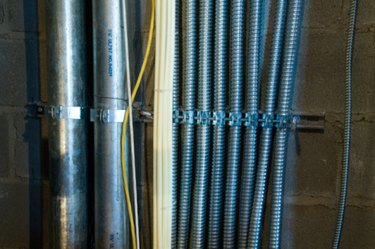
National Electric Code (NEC) covers the use of conduit in its published codes and rules. Choosing the correct diameter conduit requires using NEC tables to find wire-type diameters, fill amounts and conduit diameters. NEC specifies that a single wire may use up to 53 percent of the space inside a conduit, two wires may only use up to 31 percent, and more than two wires may not exceed 40 percent of the total available space inside a conduit.
Step 1
Choose the fill table from NEC chapter 9 that matches the type of wire and conduit you are using. For example, table 14 is for EMT type conduit and THHN or THWN wire.
Video of the Day
Step 2
Determine the diameter of the conduit by the total amount of wires when placing the same gauge and type of wire inside a conduit. Read down the first column on the fill table to locate the wire gauge. Read across from the wire gauge to find the maximum number of wires you may place inside a given conduit diameter. Select a number equal to or greater than the number of wires you will place inside the conduit.
For example, to place 15, 12-gauge wires inside EMT conduit, read down the left-most column to find 12-gauge wire. Read across the 12-gauge row until you come to 16, which is the number of 12-gauge wires allowed in ¾-inch EMT conduit.
Step 3
Calculate the total diameter of the wires to determine the diameter of the conduit when placing wires of different gauge and type inside the conduit. Find the wire diameter in table 5 for each gauge wire and type. Multiply the number of wires for each gauge and type by the wire diameter. Total the results.
For example, to use six each of 12-gauge THHN wires and 14-gauge THHN wires, we find the wire diameter of each is 0.0133 and 0.0097 respectively.
6 x 0.0133 = 0.0798 and 6 x 0.0097 = 0.0582. Totaling the results: 0.0798 + 0.0582 = 0.138.
Step 4
Find the type of conduit you wish to use in table 4. Read down for the maximum allowable fill for the type of conduit and size of conduit. Choose the first conduit fill amount that equals or exceeds the total fill calculated in the previous step.
For example, to use EMT type conduit with the previously calculated total fill of 0.138, look in the EMT column of table 4: ½-inch EMT has a maximum fill of 0.122 which is too small. However, ¾-inch EMT has a maximum fill of 0.213 which is greater than the 0.138 calculated fill. ¾-inch conduit is the correct size for this application.
Video of the Day